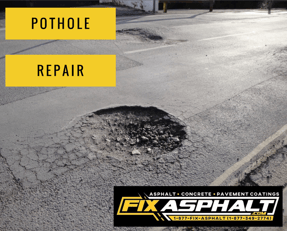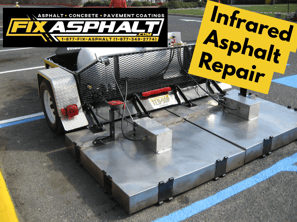Pothole Repairs & Asphalt Repair
The New Jersey market is notorious for wicked and crazy winters, damp and crazy springs, hot and humid summers and beautiful, yet wet falls. Put this all together and it makes pretty unstable conditions for your asphalt parking lot. Potholes and unexpected asphalt repairs can surface at anytime during these beautiful seasons.
We Offer Three (3) Asphalt Repair Options All Year Long:
Remove & Replace, Infrared Repairs and Throw & Patch.

Remove & Replace Asphalt Repair in NJ
(Asphalt Patching)
In the remove and replace option, (sometimes referred to asphalt patching) the damaged existing asphalt or pothole saw-cut and the damaged existing asphalt is removed.
Hot-mix asphalt is then reinstalled and compacted with a vibratory roller.
The seam is sealed with a hot-rubberized crack sealer to prevent water infiltration.
This is a widely used asphalt repair service.
 Infrared Asphalt Repair in NJ
Infrared Asphalt Repair in NJ
Infrared asphalt repair is a very cost - effective method for repairing existing asphalt in New Jersey.
- This repair method has gained popularity in the last decade due to its versatility and environmentally friendly alternative to R & R, remove and replacement method
**It Is important To Note, Infrared Asphalt Repair Is Not Designed For Every Type Of Repair in NJ, Specifically Remediating Base Failure.
- **It is also NOT designed to repair asphalt which has base failure.
- Infrared repair is ideal for potholes, bad oil spots, low spots / high spots, settling around utility structures, trip & falls hazards, sunken utility repairs and more.

Throw & Patch Asphalt Repair in NJ
(Skin Patching)
Throw and patch (sometime referred to as skin patching) is an economical option for either emergency or cost-effective asphalt and pothole repairs.
Throw and patch is typically used when potholes need to be filled immediately. It is sometimes completed before milling and paving a parking lot to remove tripping hazards.
As a final option it can be used when your budget is not sufficient to complete Remove & Replace Asphalt Repairs or Infrared Asphalt Repairs.
Throw and patch stretches your budget. It allows us to fill more potholes holes per dollar. This is because we do not have to complete any excavation work nor do we have to wait for the infrared machine to heat up.
**It is important to note, that our specialized sales and customer service representatives can help you stretch your budget. It is important to note that every asphalt job is different, if this is the first pothole or your 100th pothole we are here to help FIX YOUR ASPHALT today!





 Infrared Asphalt Repair in NJ
Infrared Asphalt Repair in NJ







